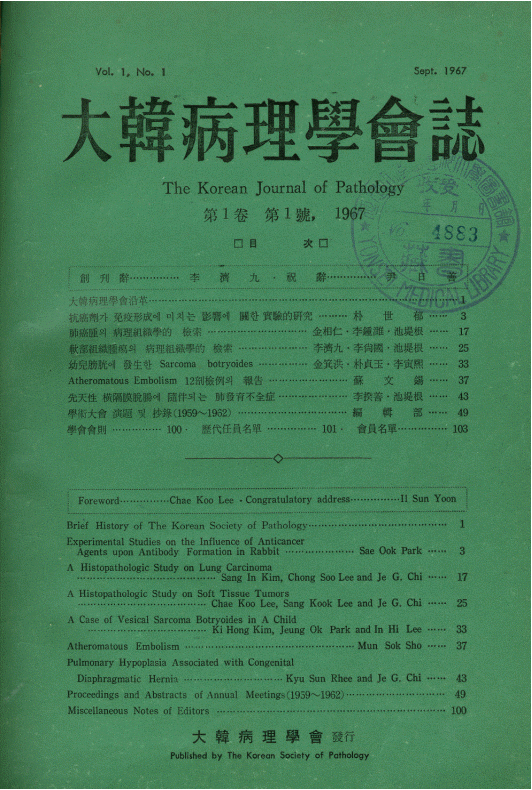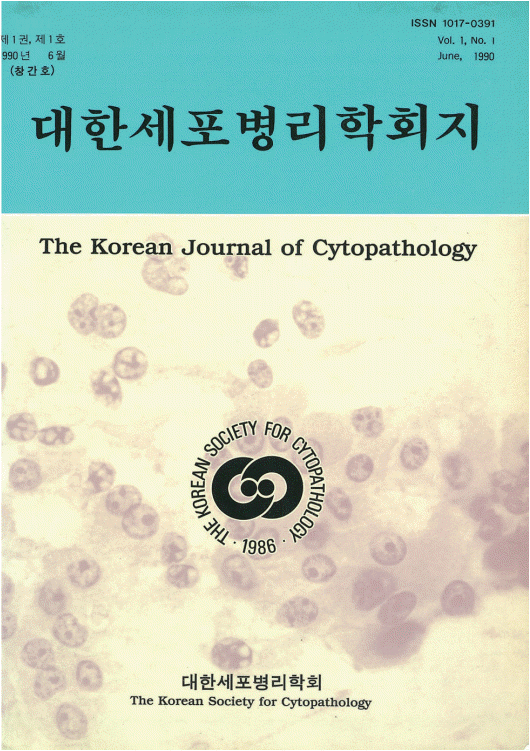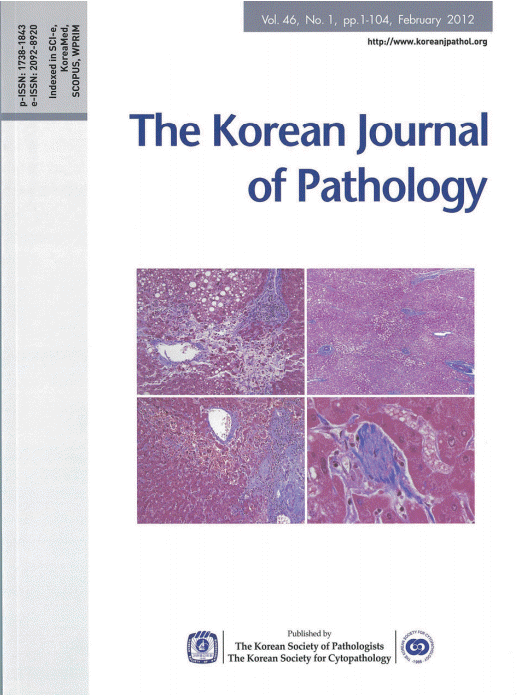Articles
- Page Path
- HOME > J Pathol Transl Med > Volume 51(1); 2017 > Article
-
Editorial
History of the Official Journal Published by the Korean Society of Pathologists: From the Korean Journal of Pathology to the Journal of Pathology and Translational Medicine - Se Hoon Kim, Chong Jai Kim1, SoonWon Hong1
-
Journal of Pathology and Translational Medicine 2017;51(1):1-6.
DOI: https://doi.org/10.4132/jptm.2017.01.07
Published online: January 13, 2017
Department of Pathology and Medical History, Yonsei University College of Medicine, Seoul, Korea
1Editors-in-Chief, Journal of Pathology and Translational Medicine
- Corresponding Author: Se Hoon Kim, MD, PhD, FIAC Department of Pathology, Yonsei University College of Medicine, 50-1 Yonsei-ro, Seodaemun-gu, Seoul 03722, Korea Tel: +82-2-2228-1769, Fax: +82-2-362-0860, E-mail: paxco@yuhs.ac
• Received: January 5, 2017 • Accepted: January 7, 2017
© 2017 The Korean Society of Pathologists/The Korean Society for Cytopathology
This is an Open Access article distributed under the terms of the Creative Commons Attribution Non-Commercial License (http://creativecommons.org/licenses/by-nc/3.0/) which permits unrestricted noncommercial use, distribution, and reproduction in any medium, provided the original work is properly cited.
- In September 1967, 20 years after the foundation of the Korean Society of Pathologists in 1947, the Korean Journal of Pathology was officially launched. Before then, pathology articles were submitted to the aforementioned university journals, the Journal of the Korean Medical Association, or other general medical journals. Publication of the society’s official journal was first agreed upon in the Board Meeting of the society in December 1961, and after 6 years in 1967, the first issue of the Korean Journal of Pathology (Fig. 1) was published on September 30. Professors Chae Koo Lee, Ki Hong Kim, Suk Jae Hong, Jong Moo Lee, Sang Kook Lee, and Sang In Kim were members of the Editorial Board [7,8]. In the first issue, the Editorial Board published Chae Koo Lee’s (president) first publication address, Il Sun Yoon’s (honorary president) congratulatory message and memoirs of two late members, In Sup Hyun (1963, Ewha Womans University) and Sung Soo Lee (1964, Seoul National University). A short history of the Korean Society of Pathologists was also included in the first issue [7].
- This historical first issue of the journal published six articles, along with programs and abstracts of the annual academic meetings of the society from 1959 to 1962, rules and regulations of the society, a list of the executives, and a list of the society members. The name of journal title was written in Chinese letters, and the first Editor-in-Chief was Professor Sang In Kim, who served for 3 years. The journal started as biannual, but it soon began to publish four times a year in 1977, and then it became bimonthly in 1991. In the early days of the publication, the journal contents were mainly composed of abstracts from the annual academic meetings of the society, but beginning in 1989, the abstracts were no longer published in the journal [7,8].
- In 1963, the Korean Society of Pathologists began to hold board examination for the residents, and 8 years later in 1975, the society decided to enforce a regulation that required at least one published article in the Korean Journal of Pathology as a prerequisite for application for the board examination. With the enactment of this regulation, the number of articles submitted to the Korean Journal of Pathology increased significantly; the number of published articles reached 123 per year in 1982. However, in 1981, the Korean Journal of Clinical Pathology was newly launched, and the number of published articles in the Korean Journal of Pathology subsequently decreased. There was one last article related to the clinical pathology in 1985, and no more clinical pathology articles were published in the Korean Journal of Pathology [7,8].
- In 1990, the Korean Journal of Pathology was officially registered in the Ministry of Culture and Media (Feb 26, Ma-1664) and it finally became a legitimate and official publication, 24 years after the journal was first started. A year later in 1991, the Korean Journal of Pathology received an ISSN (International Standardized Serial Number 0379-1149) through the Korean Academy of Medical Sciences and it was registered globally. In the same year, Professor Je Geun Chi wrote an article “The Korean Journal of Pathology: a review of the first 25 years” in the Korean Journal of Pathology (vol. 25, issue 6), in which he summarized the last 25 years of the journal and proposed Index Medicus or Science Citation Index (SCI) as the key aspiration of the journal in the upcoming years [8].
- Starting in the year 2000, articles published in the Korean Journal of Pathology became available for searching by authors, article names, and keywords. Soon after, the journal started providing abstracts and full texts. At present, PDF files of all articles can be downloaded in the journal homepage [9].
- In 2004, with the aim of being indexed in SCI, the Korean Journal of Pathology started to print the name of the journal in English with “The Korean Society of Pathologists” listed as the publisher, starting with the publication of vol. 38. The journal received a new ISSN (ISSN 1738-1843) [9].
- The first article written in English was about the pathogenesis of atherosclerosis by Sun Joo Ro in 1968 [8,10]. Afterwards, one or two English articles per year were published consistently, but in 1991, the Editorial Board decided not to publish English articles anymore. Therefore, English articles had to be submitted to other journals. In 2001, however, the Editorial Board decided to accept English articles again, and the number of English articles subsequently started to increase; the ratio of articles written in Korean and those written in English was almost 1:1 (37 vs. 35) in 2005. In 2011, to take a step ahead as a global journal, the Editorial Board announced the Korean Journal of Pathology as an all-English journal [11].
- Meanwhile, an academic interest in cytopathology within the society had grown and the members started various researches in the field. The first lecture in cytopathology was “Cytopathological evaluation of malignant tumor cells in peritoneal fluid (Sung Soo Lee and Taek Koo Yoon)” and the first abstract was “The evaluation of cytopathological diagnosis (Sang In Kim et al.)” in the 11th Annual Meeting of the Korean Society of Pathologists in 1959 [12,13]. As for the articles in cytopathology, Dong Wha Lee et al. published the first article in 1977; “The study on cytopathological diagnosis of carcinoma of the lung [14].” Afterwards, about one cytopathology article was published per year, and the number started to gradually increase as the fine needle aspiration had become popular. In 1986, the Korean Society for Cytopathology separated out from the Korean Society of Pathologists, and there was no official cytopathology journal until 1990. During that period, thirteen cytopathology articles were published in total. As the need for an official cytopathology journal had surfaced, an editorial board was put together with Jung Dal Lee as the first Editor-in-Chief in July 1990. The first issue (Fig. 2) was published on 30 June 1990, and the journal received an ISSN (ISSN 1017-0391) on 13 December 1990. In 2002, the articles published in the Korean Journal of Cytopathology since 1997 were indexed in KoreaMed, and soon afterwards, the entire archive was indexed. In 2006, it was registered as “Listed Candidate Journal” of the National Research Foundation of Korea, and it was indexed in various databases such as Google Scholar by the end of 2007 [13].
- However, despite the active academic achievements in cytopathology, the gradual decrease in the number of pathology residents across the nation, subsequent increase in the workload of pathologists, and acknowledgment of publication in the SCI journals only as the prerequisite for promotion in universities all resulted in gradual decrease in the number of submitted articles. The number of original articles as opposed to the number of case reports became significantly low and the relative acceptance rate increased. The situation was the same for the Korean Journal of Pathology and many other medical journals in Korea. As the public evaluation criteria of academic journals became more and more strict, the Korean Academy of Medical Sciences and the National Research Foundation of Korea proposed a merger of journals in the same field and announced support for such merged journals. In accordance with their proposition, the society members of both the Korean Society of Pathologists and the Korean Society for Cytopathology decided to merge their journals and publish a unified journal with better quality [11,13,15]. After much discussion on the actual terms and conditions of the merger, both societies agreed upon the “grand principle” that the unification of the two journals would be a merger, not an acquisition of one by the other. Publication costs and the number of published articles per issue were agreed to be divided in a ratio of 7:3. With confirmation of the board members of both societies (the Korean Society of Pathologists; May 15, 2008, the Korean Society for Cytopathology; May 30, 2008), the unified journal was to maintain the name “The Korean Journal of Pathology” along with its volume and issue (Fig. 3). The cover page, however, was newly designed with logos of both societies imprinted. Presidents of both societies were equally listed as the journal publisher, and the journal would have two editors-in-chief, one from each society. The Korean Journal of Cytopathology, after 19 years of its first launch, disappeared into the history and was finally reborn as “The Korean Journal of Pathology” in 2009 [13,15].
- While the merge of the two journals was still in process, the Korean Journal of Pathology was listed in SCI-expanded (SCIE), and so the articles published afterwards in the unified journal were all indexed in SCIE.
- As the Korean Journal of Pathology was an official journal of the Korean Society of Pathologists, the president of the society became the publisher ex officio. As previously said, the first Editor-in-Chief was Professor Sang In Kim. In 1970, the terms of office for both president and editor-in-chief changed to 1 year, and so the director of the general affairs undertook the role of editor-in-chief. In 1976 (vol. 10, issue 2), a new Editorial Board was organized, with Professor Eui Keun Ham as the Editor-in-Chief. Afterwards, a board of publication was newly formed within the society and the chief of the board of publication undertook the role of editor-in-chief [8].
- In October 1992, the rules and regulations of the Korean Society of Pathologists were revised, and the Council of Directors became mainly responsible for the execution of duty. Accordingly, the publication of the society’s official journal fell under the duty of the Editorial Board with the Director of Publication in charge.
- The Editorial Board was initially composed of 9–11 executive editors and 40–66 contributing editors until 2004 (vol. 38). In 2005 (vol. 39), the editors were no longer classified into executive editors and contributing editors. In 2003 (vol. 37), four of foreign pathologists were added to the Editorial Board (three from the United States and one from Hong Kong). In 2004 (vol. 38, issue 6), five pathologists from the United States additionally joined the Editorial Board [9].
- Meanwhile, in accordance with the increasing demand for a globally recognized journal, the Korean Society for Cytopathology, the Korean Society of Legal Medicine, the Korean Association of Oral and Maxillofacial Pathology, the Korean Society of Toxicologic Pathology, and the Korean Society of Veterinary Clinics together launched a journal named Basic and Applied Pathology (BAAP) in 2008 through Wiley. However, with the Korean Journal of Pathology indexed in SCIE in 2009, the journal closed after 2 years. The articles that had been published in BAAP can still be searched in the internet [11].
HISTORY OF THE KOREAN JOURNAL OF PATHOLOGY
- Although indexed in SCIE, the Korean Journal of Pathology had to go through many difficulties of its own. The impact factor was low and in plateau, and its status as “Listed Candidate Journal” of the National Research Foundation of Korea was almost insignificant. The journal applied for SCOPUS and Medline in 2010. It was accepted by SCOPUS, but rejected by Medline.
- The members of the society reached a consensus that the journal needs to be all-English; otherwise, the journal can not be indexed globally.
- So, although some members still wanted the journal to be published in Korean, the society decided to go with printing an all-English journal (first issue, published in Feb 2012) (Fig. 4) in 2011, and as a result, the journal was soon indexed in PubMed and also in Google Scholar.
- In an effort to publish an impactful journal, the society established an electronic submission system through a company named M2 Community and also created journal homepage. In order to upgrade the journal quality and encourage submission of quality articles, all accepted articles were sent for professional English editing. In addition, professional manuscript editors were hired. The journal also adopted CrossCheck and open access. In 2013, Thomson-Reuters dropped the Korean Journal of Pathology from SCIE on the grounds that the impact factor was low and in plateau from 2009 to 2012 [11].
- With the dropout from SCIE, the society began to actively discuss reapplication for SCIE and sought effective measures. In 2014, Professor SoonWon Hong took charge of the Editorial Board as Editor-in-Chief and began innovative reformation of the journal in every possible way. Soon afterwards, Professor Chong Jai Kim was recruited as co-Editor-in-Chief. The Editorial Board was totally recomposed and internationally renowned foreign editors were additionally invited as contributing editors. In 2015, the journal name was changed to the Journal of Pathology and Translational Medicine (JPTM) (Fig. 5) in an effort to renew the journal image as a more globally recognized journal. As can be imagined, it was a very difficult decision for both societies, but the editors unanimously felt the need to discard “Korea” in order to refine the international image of the journal. Instead, “Translational Medicine” was chosen to be added to the journal name with an aim to encourage authors to submit articles in the field of molecular pathology. The volume and issue of the Korean Journal of Pathology were conserved in the Journal of Pathology and Translational Medicine. The electronic submission system was replaced by ScholarOne of Thomson-Reuters, a more internationally used system. ML Communication, the printing company, was newly selected in place of Academia. Moreover, the journal started e-pub ahead and open access in order to increase the citation rate. Mobile application was developed to enhance accessibility of the journal. The instructions for authors and reviewers were rewritten. Original articles were exempt from publication fee. Authors submitting invited reviews were given an honorarium. Besides these changes in the journal itself, three members of the Editorial Board had acquired membership in the BELS (Board of Editors in the Life Sciences) and became certified editors in the life sciences: SoonWon Hong, Eunah Shin, and Sun Och Yoon. They are expected to contribute to upgrading the journal quality a step further. In November 2015, Professors SoonWon Hong and Eunah Shin visited Thomson-Reuters in Philadelphia to personally present the many improvements and accomplishments of the journal. In January the following year, Professor SoonWon Hong submitted reapplication for evaluation of the Journal of Pathology and Translational Medicine to be indexed in SCIE [11].
CRISIS AND JOURNEY OF THE KOREAN JOURNAL OF PATHOLOGY
- Re-listing in SCIE is only a short-term goal of the Journal of Pathology and Translational Medicine. In the long term, however, we need to focus on the quality improvement of the journal itself. Demands on the development of more accurate evaluation criteria for journal quality have recently been growing, and the change in journal publication in every perspective has been accelerated. In adaptation to these changes, the Journal of Pathology and Translational Medicine has to be ready to take a leading role in Asia as a pathology journal with an impact. The Editorial Board will strive to take a step ahead every moment through relentless effort and effective education. The Journal of Pathology and Translational Medicine of the Korean Society of Pathologists and the Korean Society for Cytopathology will aspire to be a globally eminent journal leading the frontier in the field of pathology.
FUTURE OF THE JOURNAL OF PATHOLOGY AND TRANSLATIONAL MEDICINE
- 1967 Official launch of the Korean Journal of Pathology
- 1981 Official launch of the Korean Journal of Clinical Pathology
- 1990 Official launch of the Korean Journal of Cytopathology
- 2004 Change in the journal title to English (the Korean Journal of Pathology) from Korean
- 2008 Official launch of the Basic and Applied Pathology
- 2009 The Korean Journal of Pathology indexed in SCIE
- 2009 Merger of the Korean Journal of Cytopathology with the Korean Journal of Pathology
- 2009 Establishment of electronic submission system
- 2010 Closure of the Basic and Applied Pathology
- 2011 Start of the Korean Journal of Pathology as an all-English journal
- 2013 The Korean Journal of Pathology dropped from SCIE
- 2015 Change in the name to the Journal of Pathology and Translational Medicine
- 2015 Replacement of the electronic submission system by ScholarOne of Thomson-Reuters
CHRONICLES IN BRIEF
Fig. 3.The first unified issue of the Korean Journal of Pathology after the merger with the Korean Journal of Cytopathology in 2009.
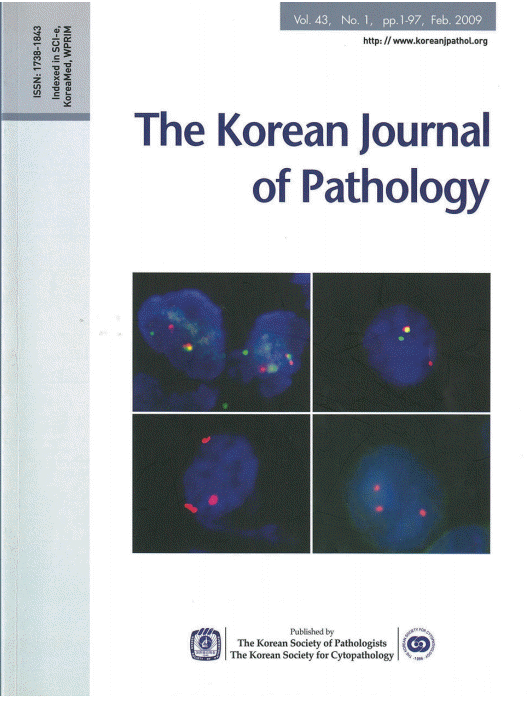

Fig. 5.The first issue of the Journal of Pathology and Translational Medicine after the change in name from the Korean Journal of Pathology in 2015.
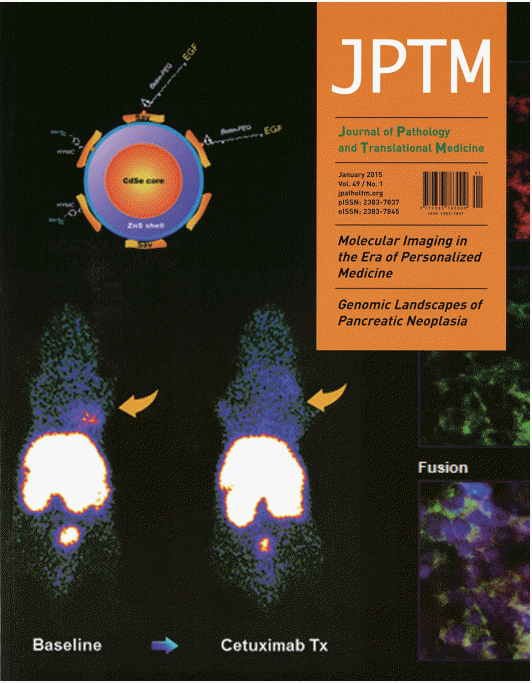

- 1. Allen HN. Surgery in the Hermit Kingdom. Medical Record 1885; 27: 671.
- 2. Avison OR. Disease in Korea. The Korean Repository. Seoul: The Trilingual Press, 1897; 207-11.
- 3. Weir HH. Arterio-sclerosis, constipation, and animal food. Br Med J 1904; 2: 863.Article
- 4. Park HW. History of research in Yonsei University, College of Medicine. Seoul: Yonsei University Press, 2014.
- 5. Korean Academy of Medical Sciences. The history of the modern Korean medicine. Seoul: Korean Academy of Medical Sciences, 1988.
- 6. Yoo HS. History of modern medical research in Korea, 1910-1945. Seoul: Korea Institute of Medicine, 2011.
- 7. Korean Society of Pathologists. The history of the Korean Society of Pathologists: its first 50 years. Seoul: Korean Society of Pathologists, 1996.
- 8. Chi JG. The Korean Journal of Pathology: a review of the first 25 years. Korean J Pathol 1991; 25: 497-508.
- 9. Korean Society of Pathologists. The history of the Korean Society of Pathologists (1996-2005). Seoul: Korean Society of Pathologists, 2006.
- 10. Ro SJ. Theory on arteriosclerosis. Korean J Pathol 1968; 2: 33-7.
- 11. Korean Society of Pathologists. The history of Korean Society of Pathologists (2006-2015). Seoul: Korean Society of Pathologists, 2016.
- 12. Korean Society for Cytopathology. The history of the Korean Society for Cytopathology, 1986-2005. Seoul: Korean Society for Cytopathology, 2007.
- 13. Jin SY, Kang CS. The Korean Journal of Cytopathology: from foundation to unification with the Korean Journal of Pathology. Korean J Pathol 2009; 43: 1-3. Article
- 14. Lee DW, Choi IJ, Lee YB, Kim DS. The study on cytopathological diagnosis of carcinoma of the lung. Korean J Pathol 1977; 11: 87-95.
- 15. Korean Society for Cytopathology. The history of the Korean Society for Cytopathology, 2006-2015. Seoul: Korean Society of Cytopathology, 2016.
REFERENCES
Figure & Data
References
Citations
Citations to this article as recorded by 

- A Multistakeholder Approach to the Airport Gate Assignment Problem: Application of Fuzzy Theory for Optimal Performance Indicator Selection
Haonan Li, Xu Wu, Yinghui Liang, Chen Zhang, Yu-Ting Bai
Computational Intelligence and Neuroscience.2021;[Epub] CrossRef
 PubReader
PubReader ePub Link
ePub Link-
 Cite this Article
Cite this Article
- Cite this Article
-
- Close
- Download Citation
- Close
- Figure
History of the Official Journal Published by the Korean Society of Pathologists: From the Korean Journal of Pathology to the Journal of Pathology and Translational Medicine





Fig. 1. The first issue of the Korean Journal of Pathology in 1967.
Fig. 2. The first issue of the Korean Journal of Cytopathology in 1990.
Fig. 3. The first unified issue of the Korean Journal of Pathology after the merger with the Korean Journal of Cytopathology in 2009.
Fig. 4. The first all-English issue of the Korean Journal of Pathology in 2012.
Fig. 5. The first issue of the Journal of Pathology and Translational Medicine after the change in name from the Korean Journal of Pathology in 2015.
Fig. 1.
Fig. 2.
Fig. 3.
Fig. 4.
Fig. 5.
History of the Official Journal Published by the Korean Society of Pathologists: From the Korean Journal of Pathology to the Journal of Pathology and Translational Medicine

 E-submission
E-submission
